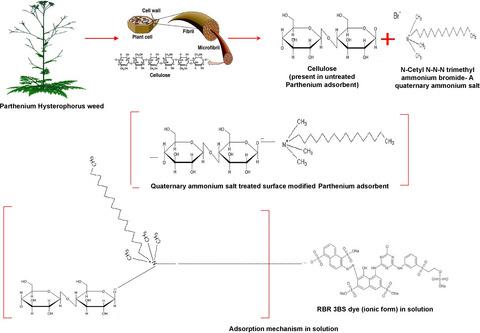当前位置:
X-MOL 学术
›
Coloration Technol.
›
论文详情
Our official English website, www.x-mol.net, welcomes your
feedback! (Note: you will need to create a separate account there.)
Efficacy of parthenium hysterophorus waste biomass compared with activated charcoal for the removal of CI Reactive Red 239 textile dye from wastewater
Coloration Technology ( IF 2.0 ) Pub Date : 2021-01-24 , DOI: 10.1111/cote.12526 Shreyas Bapat 1 , Dipika Jaspal 1 , Arti Malviya 2
Coloration Technology ( IF 2.0 ) Pub Date : 2021-01-24 , DOI: 10.1111/cote.12526 Shreyas Bapat 1 , Dipika Jaspal 1 , Arti Malviya 2
Affiliation

|
In the quest to find an eco‐friendly, cost‐effective and efficient alternative to expensive and non‐biodegradable activated charcoal (AC), in the current study the potential of a weed, parthenium hysterophorus (PH), has been explored as a bio‐adsorbent for purification of textile wastewater. Root, stem and leaves of PH weed have been used as bio‐adsorbents in raw and surface‐treated forms and compared with AC for removal of toxic textile dye CI Reactive Red 239 (Remazol Brilliant Red 3BS [RBR 3BS]) from wastewater. The surface treatment carried out using QAS (N‐Cetyl‐N,N,N–trimethylammonium bromide) in the current study is a novel way to enhance the dye adsorption capacity of raw adsorbents of PH. Characterisation tools like Fourier Transform–infrared spectroscopy, scanning electron microscopy, elemental analysis and potential of zero charge have been used to confirm the surface treatment. The impact of various process variables like pH, dosage of adsorbent, contact time, solution temperature and dye concentration have been studied. Isothermal, kinetic and thermodynamics modelling for adsorption data have been thoroughly investigated to ascertain the mechanism of adsorption. Statistical error functions like root mean square error, chi‐square test, sum of absolute error and normalized standard deviation (NSD) have been used to validate the adsorption data. Results revealed that novel surface treatment significantly improved the dye adsorption capacity of raw PH adsorbents (ca. 15‐16 times). Of all the weed bio‐adsorbents, surface‐treated PH stem showed the highest dye adsorption capacity (105 mg/g), which was 10‐folds greater than commercial grade AC (10.4 mg/g at 27°C). For both adsorbents, surface‐treated PH stem and AC, adsorption followed pseudo‐second order kinetics, and the Langmuir isotherm was the best fit with film diffusion as a rate‐controlling step. Thermodynamic parameters infer the spontaneous and exothermic nature of adsorption. Therefore, in the current study, surface‐treated PH stem bio‐adsorbent has been revealed as a superior alternative to AC for the removal of RBR 3BS dye from wastewater, opening a new gateway to the utilisation of waste weeds for the purpose of wastewater treatment.
中文翻译:

hen废物生物量与活性炭相比去除废水中CI活性红239纺织染料的功效。
为了寻找一种生态环保,具有成本效益的高效替代昂贵且不可生物降解的活性炭(AC)的替代品,在当前的研究中,人们已经探索了杂草孤hen(PH)的潜力,将其作为生物吸附剂,用于净化纺织废水。PH杂草的根,茎和叶已被用作原始和表面处理形式的生物吸附剂,并与AC进行了比较,以从废水中去除有毒的纺织染料CI Reactive Red 239(Remazol亮红色3BS [RBR 3BS])。使用QAS(N-十六烷基N,N,N-溴化三甲基铵)是提高PH原始吸附剂对染料的吸附能力的一种新方法。诸如傅立叶变换红外光谱,扫描电子显微镜,元素分析和零电荷电势等表征工具已用于确认表面处理。研究了各种工艺变量(如pH值,吸附剂的用量,接触时间,溶液温度和染料浓度)的影响。已对吸附数据的等温,动力学和热力学模型进行了深入研究,以确定吸附机理。统计误差函数(如均方根误差,卡方检验,绝对误差之和和标准化标准偏差(NSD))已用于验证吸附数据。CA。15-16次)。在所有杂草生物吸附剂中,经表面处理的PH茎表现出最高的染料吸附能力(105 mg / g),比商品级AC(在27°C时为10.4 mg / g)高10倍。对于两种吸附剂,经过表面处理的PH杆和AC,吸附均遵循拟二级动力学,而Langmuir等温线最适合于薄膜扩散作为速率控制步骤。热力学参数推断吸附的自发性和放热性。因此,在当前的研究中,表面处理的PH茎生物吸附剂已被证明是AC的最佳替代品,可从废水中去除RBR 3BS染料,从而为利用杂草进行废水处理开辟了一条新途径。
更新日期:2021-01-24
中文翻译:

hen废物生物量与活性炭相比去除废水中CI活性红239纺织染料的功效。
为了寻找一种生态环保,具有成本效益的高效替代昂贵且不可生物降解的活性炭(AC)的替代品,在当前的研究中,人们已经探索了杂草孤hen(PH)的潜力,将其作为生物吸附剂,用于净化纺织废水。PH杂草的根,茎和叶已被用作原始和表面处理形式的生物吸附剂,并与AC进行了比较,以从废水中去除有毒的纺织染料CI Reactive Red 239(Remazol亮红色3BS [RBR 3BS])。使用QAS(N-十六烷基N,N,N-溴化三甲基铵)是提高PH原始吸附剂对染料的吸附能力的一种新方法。诸如傅立叶变换红外光谱,扫描电子显微镜,元素分析和零电荷电势等表征工具已用于确认表面处理。研究了各种工艺变量(如pH值,吸附剂的用量,接触时间,溶液温度和染料浓度)的影响。已对吸附数据的等温,动力学和热力学模型进行了深入研究,以确定吸附机理。统计误差函数(如均方根误差,卡方检验,绝对误差之和和标准化标准偏差(NSD))已用于验证吸附数据。CA。15-16次)。在所有杂草生物吸附剂中,经表面处理的PH茎表现出最高的染料吸附能力(105 mg / g),比商品级AC(在27°C时为10.4 mg / g)高10倍。对于两种吸附剂,经过表面处理的PH杆和AC,吸附均遵循拟二级动力学,而Langmuir等温线最适合于薄膜扩散作为速率控制步骤。热力学参数推断吸附的自发性和放热性。因此,在当前的研究中,表面处理的PH茎生物吸附剂已被证明是AC的最佳替代品,可从废水中去除RBR 3BS染料,从而为利用杂草进行废水处理开辟了一条新途径。











































 京公网安备 11010802027423号
京公网安备 11010802027423号